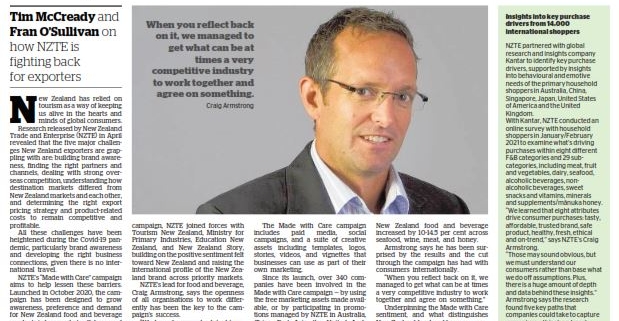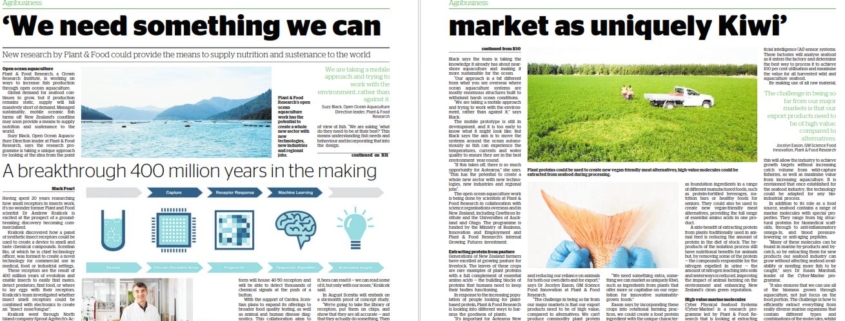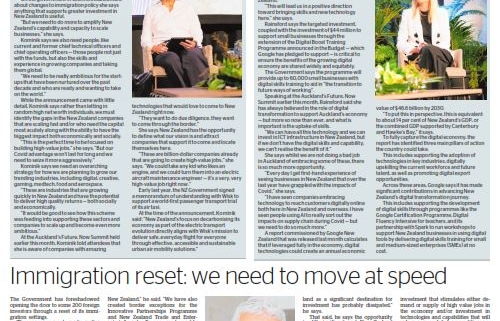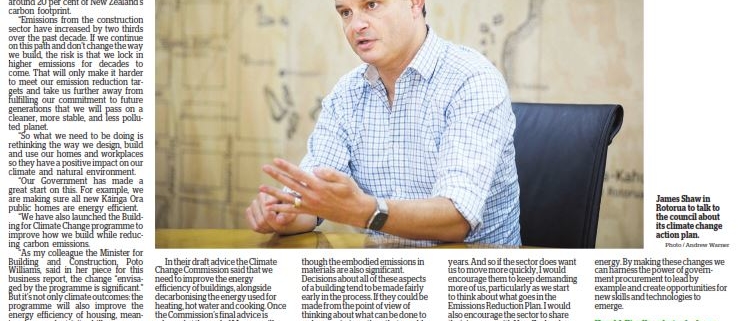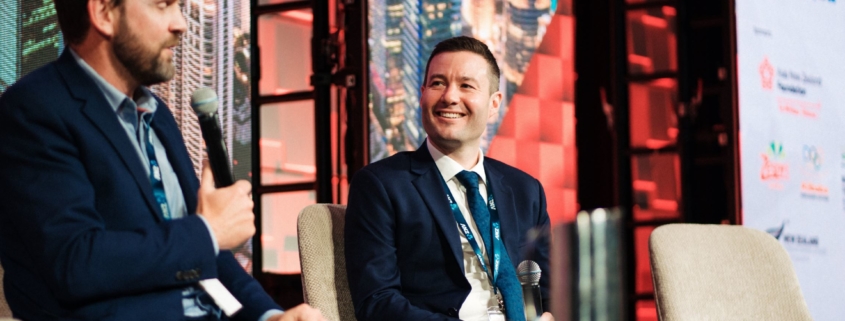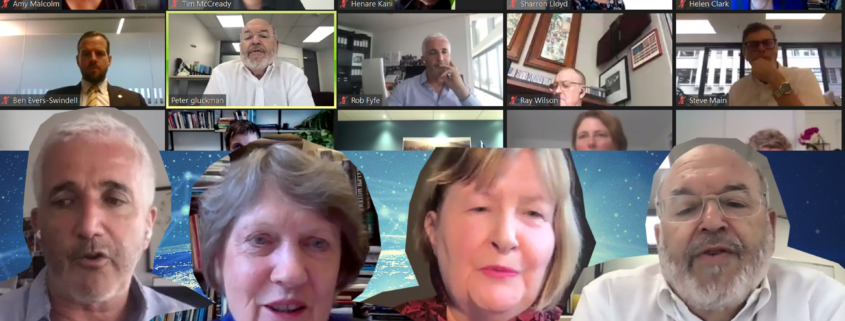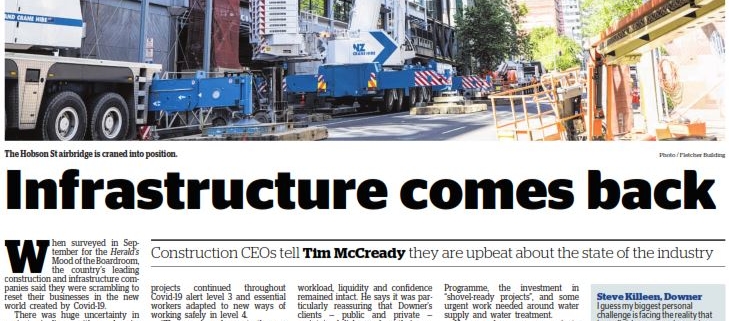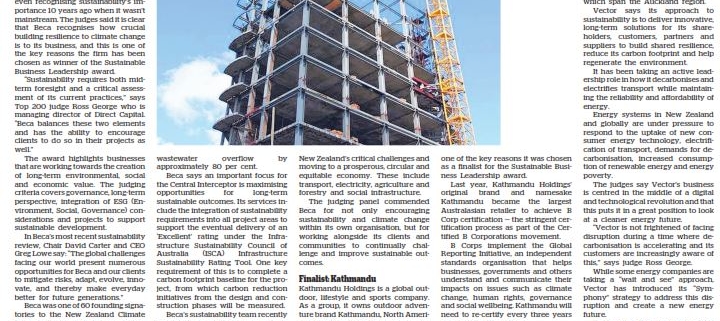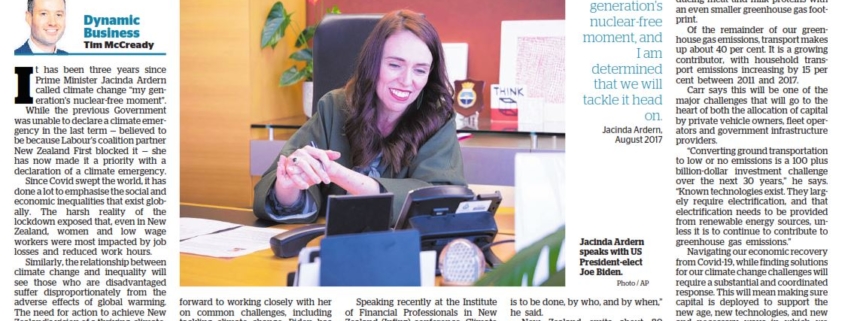Agribusiness Report: Why care is a consideration, according to NZTE
New Zealand has relied on tourism as a way of keeping us alive in the hearts and minds of global consumers.
Research released by New Zealand Trade and Enterprise (NZTE) in April revealed that the five major challenges New Zealand exporters are grappling with are: building brand awareness, finding the right partners and channels, dealing with strong overseas competition, understanding how destination markets differed from New Zealand markets and each other, and determining the right export pricing strategy and product-related costs to remain competitive and profitable.
All these challenges have been heightened during the Covid-19 pandemic, particularly brand awareness and developing the right business connections, given there is no international travel.
NZTE’s “Made with Care” campaign aims to help lessen these barriers. Launched in October 2020, the campaign has been designed to grow awareness, preference and demand for New Zealand food and beverage products in key markets offshore, and share New Zealand’s commitment to being a trusted, sustainable global food source. It provides New Zealand food and beverage exporters access to a suite of free, ready-made marketing assets to use in their own sales and marketing efforts.
The campaign is part of a wider “Messages from NZ” country brand campaign — a New Zealand Inc effort to raise our international profile in key markets across trade, education and tourism with international consumers, buyers, and investors to help rebuild our economy.
To establish the Made with Care campaign, NZTE joined forces with Tourism New Zealand, Ministry for Primary Industries, Education New Zealand, and New Zealand Story, building on the positive sentiment felt toward New Zealand and raising the international profile of the New Zealand brand across priority markets.
NZTE’s lead for food and beverage, Craig Armstrong, says the openness of all organisations to work differently has been the key to the campaign’s success.
“We have borrowed a lot of tourism people for the last 15 months to make this work — it’s been fantastic,” he says. “It really became a partnership to say: ‘Well, how can we promote New Zealand products, as opposed to promoting New Zealand as a destination?'”.
Armstrong says businesses were telling NZTE the biggest issue for them was not being able to be in market to talk to buyers and consumers.
“What we realised was that we could use this budget to talk to shoppers and buyers at a time when New Zealand businesses could not get there and do it themselves.”
The Made with Care campaign includes paid media, social campaigns, and a suite of creative assets including templates, logos, stories, videos, and vignettes that businesses can use as part of their own marketing.
Since its launch, over 340 companies have been involved in the Made with Care campaign — by using the free marketing assets made available, or by participating in promotions managed by NZTE in Australia, China, East Asia, the United Arab Emirates, the UK and North America.
NZTE says because of the campaign, preference and appeal measures for New Zealand food and beverage are trending slightly upwards. As an example, after a short burst of promotional activity in the UK, spontaneous awareness of New Zealand as a country that produces premium quality food and beverage increased 5 per cent, with 57 per cent of research respondents stating they have either bought or are considering buying food and drink from New Zealand because of seeing the campaign.
In North America, awareness of New Zealand food and beverage increased by 10-14.5 per cent across seafood, wine, meat, and honey.
Armstrong says he has been surprised by the results and the cut through the campaign has had with consumers internationally.
“When you reflect back on it, we managed to get what can be at times a very competitive industry to work together and agree on something.”
Underpinning the Made with Care sentiment, and what distinguishes New Zealand food and beverage products from others, is the principle of Taiao — the interconnectedness of our people and the natural world.
The values of Kaitiakitanga (guardians, caring for people, place and planet, now and for future generations), Manaakitanga (caring for others and showing hospitality, kindness, generosity, support and respect) and Ingenuity (challenging the status quo with original and bold solutions) are also woven throughout the campaign messaging.
This interconnectedness of people and the natural world, and the desire for sustainable, safe and innovative products are all aspects of the megatrends that are currently shaping the industry, and Armstrong says the desire for these attributes have all been accelerated due to the pandemic.
“What Covid has done is really bring forward consumers’ changing preferences by years — whether that is five years, six years, 10 years… I’m not quite sure,” he says. “But what we are seeing now is a need or a preference from consumers that is playing into New Zealand’s hands. We are a very ethical producer of food, treat our people well, treat our animals well, and generally treat our land well.
“We have got to be able to tell that story and be able to capitalise on what most advanced and developing economies now care about.”
He says telling that story is critical, and that most of the growth from exporters is not hampered because we are not in the right markets or don’t have the right product, but rather because people don’t spend any money on marketing and telling their story.
“Look at the results we are getting through the Made with Care campaign,” he says. “Those kinds of numbers should give you an indication that if you invest in marketing and look at it as an investment, rather than a cost, you will get a return out of it.”
Insights into key purchase drivers from 14,000 international shoppers
NZTE partnered with global research and insights company Kantar to identify key purchase drivers, supported by insights into behavioural and emotive needs of the primary household shoppers in Australia, China, Singapore, Japan, United States of America and the United Kingdom.
With Kantar, NZTE conducted an online survey with household shoppers in January/February 2021 to examine what’s driving purchases within eight different F&B categories and 29 sub-categories, including meat, fruit and vegetables, dairy, seafood, alcoholic beverages, non-alcoholic beverages, sweet snacks and vitamins, minerals and supplements/mānuka honey.
“We learned that eight attributes drive consumer purchases: tasty, affordable, trusted brand, safe product, healthy, fresh, ethical and on-trend,” says NZTE’s Craig Armstrong.
“Those may sound obvious, but we must understand our consumers rather than base what we do off assumptions. Plus, there is a huge amount of depth and data behind these insights.”
Armstrong says the research found five key paths that companies could take to capture a premium: ethical, on-trend, health, safe product and trusted brand. However, he says these vary depending on the market and category, so how businesses construct and communicate their offer needs to be tailored.
“For example, China is influenced by health and safety; Japan by health, taste and freshness; Singapore contains a broader spread of drivers; while Western markets are more driven by affordability, taste and trusted brand.
“However, affordability and taste do not pull in a premium whereas there is real potential for ethical and on-trend purchases to do so, particularly in the US.”
Locking in brand sustainability
David Babich, chief executive of Babich Wines says they have seen a 4 per cent lift in website traffic over the time Made with Care has been running.
“While not double-digit growth, it is off good base traffic and in an environment where the investment (hence competitiveness) in this area has been intense due to the global constraint on face-to-face.
“As an exporter you have to make an investment in travel and visiting customers. While people understand the reasons why we can’t visit, the time that you can get away with not doing that is fundamentally finite.
“We are going to hit two years without visiting our customers, and meanwhile other competitors are either domiciled in the market or have face-to-face market access because of their own infrastructure — especially the large players.
“We have four people in the US, three in China, one in the UK, so we are not without representation in our key markets, but we don’t have an enormous team to continue to push our message relentlessly. A lot of other NZ companies are in that situation.
“Since we can’t put a billboard in Times Square, social media has worked particularly well for us to market to the world and get our brand messaging out.
“What has resonated for us in the Made with Care Campaign is that one of our brand platforms is sustainability.
“We lock right into that.”

